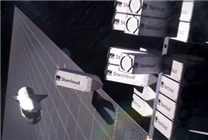The Future of AI: Crusoe and NVIDIA’s H100 GPU Launch into Space
Summary:
- Crusoe is set to become the first public cloud operator to deploy AI workloads in space using NVIDIA’s H100 GPU.
- The innovative partnership aims to harness solar energy from space, significantly lowering energy costs for data centers.
- This ambitious project seeks to make cutting-edge AI computing exponentially more powerful and sustainable.
In a groundbreaking move, Crusoe Technologies, in partnership with Starcloud, is gearing up to launch NVIDIA’s H100 GPU into space next month. This initiative marks a pivotal step in integrating artificial intelligence (AI) with aerospace technology. According to reports, this endeavor will establish Crusoe as the first public cloud provider to run AI workloads in a space environment.
Pioneering AI Computing Power
The orbital Crusoe Cloud service will utilize NVIDIA’s H100 GPU deployed aboard Starcloud’s artificial intelligence data center satellite. This strategic partnership claims that the computing power offered by the H100 will be a remarkable 100 times more potent than any existing capabilities in space. This monumental leap in technology could redefine the limits of AI processing.
Harnessing Space Solar Energy
One of the project’s most ambitious aspects is its commitment to sustainability. Crusoe and Starcloud plan to develop AI data center infrastructures powered entirely by solar energy harvested in space. Unlike Earth, where atmospheric conditions can hinder solar energy efficiency, satellites can access "almost unlimited, low-cost renewable energy." This innovation has the potential to cut energy costs—factoring in launch expenses—by up to tenfold compared to terrestrial data centers.
Additionally, deploying large-scale solar panel arrays in space sidesteps the land-use issues that often complicate renewable energy initiatives on the ground. This model also alleviates pressure on Earth’s energy resources, aligning with global sustainability goals.
Overcoming Technical Challenges
A critical challenge that arises with GPU deployment in space is heat dissipation. Traditional data centers rely on convection models for cooling, which may not be applicable in a vacuum. NVIDIA proposes utilizing the vastness of deep space as an "infinite radiator," effectively addressing the heat management issue.
Timeline and Future Prospects
Current plans indicate that Starcloud will launch the H100 GPU into space in November 2025. Following this, Crusoe aims to have its cloud service operational on Starcloud satellites by the end of 2026. Ultimately, the goal is to offer GPU computing power from space starting in early 2027.
Conclusion
The collaboration between Crusoe Technologies and Starcloud heralds a new era in AI and computing capabilities. By leveraging cutting-edge technology and sustainable energy solutions, they are not only pushing the boundaries of what is possible in computing but also addressing pressing environmental challenges. As this ambitious project unfolds, it will undoubtedly garner interest from tech enthusiasts and industry leaders alike, positioning itself as a pioneering force in the ongoing evolution of cloud computing and artificial intelligence.
With this innovative trajectory towards utilizing space for technological advancement, the future looks bright for AI development and energy sustainability.





